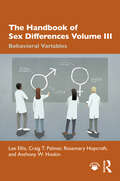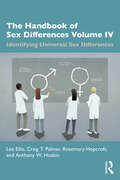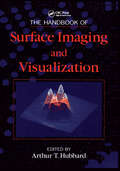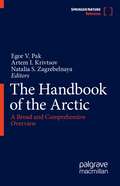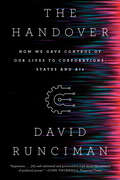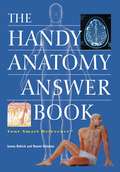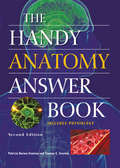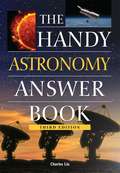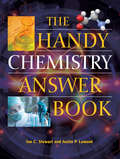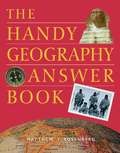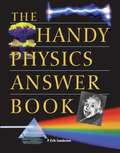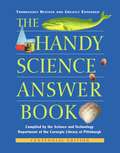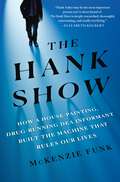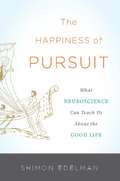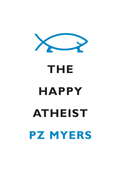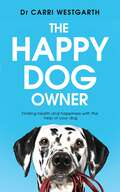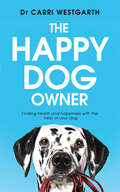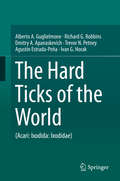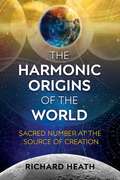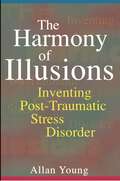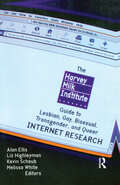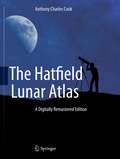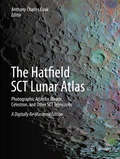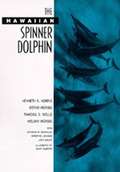- Table View
- List View
The Handbook of Sex Differences Volume III Behavioral Variables (The Handbook of Sex Differences)
by Craig T. Palmer Lee Ellis Anthony W. Hoskin Rosemary HopcroftThe Handbook of Sex Differences is a four-volume reference work assembled and written to assess sex differences in human traits (although findings regarding other species are also included). Based on the authors’ highly influential 2008 book Sex Differences, these volumes highlight important new research findings from the last decade and a half alongside earlier findings. Conclusions reached by meta-analyses are also included. In this, the work’s third volume, findings from thousands of studies pertaining to behavior, broadly defined, are summarized. Traits covered include those involving personality, social behavior, criminality, work, and sex stereotypes. The eight chapters comprising Volume III are as follows: 16. Personality and Behavioral Tendencies 17. Social Behavior 18. Acquiring, Selling, and Consuming Behavior 19. Criminality, Near-Criminality, and Victimization 20. Education, Work, Social Status, and Territorial Behavior 21. Sex Stereotypes 22. Attitudes and Actions Toward Others According to their Sex 23. Ecologically Based Sex Differences The Handbook of Sex Differences is of significant importance for any researcher, student, or professional who requires a comprehensive resource on sex differences.
The Handbook of Sex Differences Volume IV Identifying Universal Sex Differences (The Handbook of Sex Differences)
by Craig T. Palmer Lee Ellis Anthony W. Hoskin Rosemary HopcroftThe Handbook of Sex Differences is a four-volume reference work written to assess sex differences, with a primary focus on the human species. Based on the authors’ highly influential 2008 book Sex Differences, these volumes highlight important new research findings from the last decade and a half alongside earlier findings. In this, the work’s fourth and last volume, two related questions are addressed: Are there universal sex differences (i.e., sex differences found in all societies)? And if the answer is yes, what are they and how can each one be theoretically explained? To answer the first of these two questions, this volume condenses much of the research findings amassed in the book’s first three volumes into summary tables. Then, to help identify likely universal sex differences, three versions of social role theory and two versions of evolutionary theory are examined relative to each possible universal sex difference. Consideration is even given to religious scriptures as a sixth type of explanation. In the concluding analyses, 308 likely universal sex differences are identified. No single theory was able to explain all these differences. Nevertheless, the two evolutionary theories were better in this regard than any of the three social role theories, including the recently proposed biosocial version of social role theory. The Handbook of Sex Differences is of importance for any researcher, student, or professional who requires a comprehensive resource on sex differences.
The Handbook of Surface Imaging and Visualization
by Arthur T. HubbardThis exciting new handbook investigates the characterization of surfaces. It emphasizes experimental techniques for imaging of solid surfaces and theoretical strategies for visualization of surfaces, areas in which rapid progress is currently being made. This comprehensive, unique volume is the ideal reference for researchers needing quick access to the latest developments in the field and an excellent introduction to students who want to acquaint themselves with the behavior of electrons, atoms, molecules, and thin-films at surfaces. It's all here, under one cover!The Handbook of Surface Imaging and Visualization is filled with sixty-four of the most powerful techniques for characterization of surfaces and interfaces in the material sciences, medicine, biology, geology, chemistry, and physics. Each discussion is easy to understand, succinct, yet incredibly informative. Data illustrate present research in each area of study. A wide variety of the latest experimental and theoretical approaches are included with both practical and fundamental objectives in mind. Key references are included for the reader's convenience for locating the most recent and useful work on each topic. Readers are encouraged to contact the authors or consult the references for additional information.This is the best ready reference available today. It is a perfect source book or supplemental text on the subject.
The Handbook of the Arctic: A Broad and Comprehensive Overview
by Egor V. Pak Artem I. Krivtsov Natalia S. ZagrebelnayaThis book offers a broad and holistic overview of issues in the Arctic today, a region which is transforming due to changing world order and climate agenda. While new economic opportunities - and with China, as well as other geopolitical players in the region - are emerging, new security challenges are arising as well. In this comprehensive scholarly resource, contributors from around the world and from a broad variety of disciplines share their thoughts on the future of the Arctic, in a manuscript that will be of interest to researchers, economists, and policymakers.
The Handover: How We Gave Control of Our Lives to Corporations, States and AIs
by David Runciman“[W]itty and refined . . . Runciman’s point is that the alliance between even a democratic government and a safe-ish A.I. could derail civilization.” —Gideon Lewis-Kraus, New Yorker An eminent political thinker uses our history with states and corporations—“artificial agents” to which we have granted immense power—to predict how AI will remake society. Countless books, news reports, and opinion pieces have announced the impending arrival of artificial intelligence, with most claiming that it will upend our world, revolutionizing not just work but society overall. Yet according to political philosopher and historian David Runciman, we’ve actually been living with a version of AI for 300 years because states and corporations are robots, too. In The Handover, Runciman explains our current situation through the history of these “artificial agents” we created to rescue us from our all-too-human limitations—and demonstrates what this radical new view of our recent past means for our collective future. From the United States and the United Kingdom to the East India Company, Standard Oil, Facebook, and Alibaba, states and corporations have gradually, and then much more rapidly, taken over the planet. They have helped to conquer poverty and eliminate disease, but also unleashed global wars and environmental degradation. As Runciman demonstrates, states and corporations are the ultimate decision-making machines, defined by their ability to make their own choices and, crucially, to sustain the consequences of what has been chosen. And if the rapid spread of the modern state and corporation has already transformed the conditions of human existence, new AI technology promises the same. But what happens when AI interacts with other kinds of artificial agents, the inhuman kind represented by states and corporations? Runciman argues that the twenty-first century will be defined by increasingly intense battles between state and corporate power for the fruits of the AI revolution. In the end, it is not our own, human relationship with AI that will determine our future. Rather, humanity’s fate will be shaped by the interactions among states, corporations, and thinking machines. With clarity and verve, The Handover presents a brilliantly original history of the last three centuries and a new understanding of the immense challenges we now face.
The Handy Anatomy Answer Book
by Naomi Balaban James BobickFrom basic biology and the lymphatic system to human growth and development, this comprehensive reference-organized by systems of the body-makes the sometimes perplexing nature of anatomy understandable through an engaging question-and-answer format. In addition to the science itself, the people and history behind anatomy are discussed. More than 1,200 questions are answered, including Do identical twins have the same fingerprints? What are the primary sensations of taste? What is the integumentary system? and How many bones are in the human body?
The Handy Anatomy Answer Book
by Patricia Barnes-Svarney Thomas E. SvarneyWe all have one. The human body. But do we really know all of its parts and how they work? The Handy Anatomy Answer Book is the key to unlocking this door to a wondrous world. Covering all the major body systems--integumentary (skin, hair, etc. ), skeletal, muscular, nervous, sensory, endocrine, cardiovascular, lymphatic, respiratory, digestive, urinary, and reproductive, and, for good measure, adds chapters on growth and development and how science can help and augment the body--it follows the fascinating maze of organ systems and shows how much the body does routinely just to let you move, breathe, eat, and fight off disease. This handy reference helps make the language of anatomy--as well as physiology and pathology--more understandable and less intimidating. Fascinating trivia, plus serious facts, combine to answer over 1,200 questions about the human body, including What is Gray’s Anatomy? What does it mean to have 20/20 vision? Why is blood sticky? How does exercise affect the heart? What is "gluten intolerance”? Is urine always yellow in color? What are the seven warning signs of Alzheimer’s disease? What is a reflex? How much sleep does an individual need? Can humans use organs from other animals for transplants?
The Handy Astronomy Answer Book
by Charles LiuFrom planetary movements and the exploration of our solar system to black holes and dark matter, this comprehensive reference simplifies all aspects of astronomy with an approachable question-and-answer format. With chapters broken into various astronomical studies-including the universe, galaxies, planets, and space exploration-this fully updated resource is an ideal companion for students, teachers, and amateur astronomers, answering more than 1,00 questions, such as Is the universe infinite? What would happen to you if you fell onto a black hole? What are the basic concepts of Einstein's special theory of relativity? and Who was the first person in space?
The Handy Chemistry Answer Book
by Justin P. Lomont Ian C. StewartSimplifying the complex chemical reactions that take place in everyday through the well-stated answers for more than 600 common chemistry questions, this reference is the go-to guide for students and professionals alike. The book covers everything from the history, major personalities, and groundbreaking reactions and equations in chemistry to laboratory techniques throughout history and the latest developments in the field. Chemistry is an essential aspect of all life that connects with and impacts all branches of science, making this readable resource invaluable across numerous disciplines while remaining accessible at any level of chemistry background. From the quest to make gold and early models of the atom to solar cells, bio-based fuels, and green chemistry and sustainability, chemistry is often at the forefront of technological change and this reference breaks down the essentials into an easily understood format.
The Handy Geography Answer Book
by Paul A Tucci Mathew Todd RosenbergAn expert on the unexplained and paranormal research, Brad and Sherry Steiger turn their unique and remarkable talents to the bold storytelling of encounters with the unknown from throughout the ages. From mysterious strangers and unpredictable beings to weird behavior and paranormal phenomena, they investigate claims of visits from ghastly ghosts, otherworldly creatures, aliens living among us, phantoms, spirits and other accounts of encounters with the unexplained. Over 130 astounding accounts of Real Encounters with the supernatural, such as ... *Visitors from others worlds who have had Earth under surveillance for centuries, conducting their activities in secret-- even abducting humans for their own research and undeclared ends. *Members of secret societies who developed an advanced technology centuries ago which has been kept hidden in underground or undersea cities. *Time Travelers from the Future. Beings who claim to be our descendents from the future who are returning to study the true destiny of humankind. *Ghosts that haunt people, places, and things--and poltergeists that create havoc. *Beasties and monsters found in everyone's worst nightmares--and sometimes in their campsites, fields, and yards. *Other Dimensional Visitors, Beings, Creatures, or Entities that come not from a faraway world in our solar system or any other, but from an adjacent space-time continuum existing on another vibrational/dimensional frequency or level. *Previously unknown, unidentified terrestrial life-forms, such beings as "sky-critters," "sky fish," "rods," and "orbs." *As yet unknown physical energies that may be activated by the psyche, the unconscious level of the human mind. *Archetypal creatures and entities of the collective unconscious that are the result of energies that are accessible through dreams, meditations, and other states of altered consciousness. *Interactions with beings that have been dubbed elves, fairies, devas throughout the centuries. *The marvelous, creative facet of dreams. *Out-of-body mind-traveling through Time and Space. *Majestic beings who are described in the scriptures of many world religions as angels or demons.
The Handy Physics Answer Book
by Paul W ZitzewitzAnswers more than eight hundred questions about physics, ranging from everyday life applications to the latest explorations in the field.
The Handy Science Answer Book
by The Carnegie Library of PittsburghPresenting a fun and educational way to explore the wonders of the world of science, this newly updated edition poses and answers 2,200 questions, providing an abundance of original and interesting science facts. Children and adults will uncover some of the most interesting, unusual, and quirky science curiosities such as: Are cell phones dangerous to your health? Is the same strain of yeast used to make different types of beer? What is the cleanest fossil fuel? What is the largest invertebrate? Readers will find this informative and enjoyable resource is chock full of hundreds of intriguing science and technology topics, from the inner workings of the human body and outer space to math, computers, planes, trains, and automobiles.
The Hank Show: How a House-Painting, Drug-Running DEA Informant Built the Machine That Rules Our Lives
by McKenzie FunkThe bizarre and captivating story of the most important person you've never heard of.The world we live in today, where everything is tracked by corporations and governments, originates with one manic, elusive, utterly unique man—as prone to bullying as he was to fits of surpassing generosity and surprising genius. His name was Hank Asher, and his life was a strange and spectacular show that changed the course of the future.In The Hank Show, critically acclaimed author and journalist McKenzie Funk relates Asher's stranger-than-fiction story—he careened from drug-running pilot to alleged CIA asset, only to be reborn as the pioneering computer programmer known as the father of data fusion. He was the multimillionaire whose creations now power a new reality where your every move is tracked by police departments, intelligence agencies, political parties, and financial firms alike. But his success was not without setbacks. He truly lived nine lives, on top of the world one minute, only to be forced out of the companies he founded and blamed for data breaches resulting in major lawsuits and market chaos.In the vein of the blockbuster movie Catch Me if You Can, this spellbinding work of narrative nonfiction propels you forward on a forty year journey of intrigue and innovation, from Colombia to the White House and from Silicon Valley to the 2016 Trump campaign, focusing a lens on the dark side of American business and its impact on the everyday fabric of our modern lives.
The Happiness of Pursuit: What Neuroscience Can Teach Us About the Good Life
by Shimon EdelmanWhen fishing for happiness, catch and release. Remember these seven words-they are the keys to being happy. So says Shimon Edelman, an expert on psychology and the mind. In The Happiness of Pursuit, Edelman offers a fundamental understanding of pleasure and joy via the brain. Using the concept of the mind as a computing device, he unpacks how the human brain is highly active, involved in patterned networks, and constantly learning from experience. As our brains predict the future through pursuit of experience, we are rewarded both in real time and in the long run. Essentially, as Edelman discovers, it’s the journey, rather than the destination, that matters. The idea that cognition is computation-the brain is a machine-is nothing new of course. But, as Edelman argues, the mind is actually a bundle of ongoing computations, essentially, the brain being one of many possible substrates that can support them. Edelman makes the case for these claims by constructing a conceptual toolbox that offers readers a glimpse of the computations underlying the mind’s faculties: perception, motivation and emotions, action, memory, thinking, social cognition, learning and language. It is this collection of tools that enables us to discover how and why happiness happens. An informative, accessible, and witty tour of the mind, The Happiness of Pursuit offers insights to a thorough understanding of what minds are, how they relate to each other and to the world, and how we can make the best of it all.
The Happy Atheist
by Pz Myers"I'm an atheist swimming in a sea of superstition, surrounded by well-meaning, good people with whom I share a culture and similar concerns, and there's only one thing I can do. I have to laugh." --PZ Myers Through his popular science blog, Pharyngula, PZ Myers has entertained millions of readers with his infectious love of evolutionary science and his equally infectious disdain for creationism, biblical literalism, intelligent design theory, and other products of godly illogic. In this funny and fearless book, Myers takes on the religious fanaticism of our times with the gleeful disrespect it deserves, skewering the apocalyptic fantasies, magical thinking, hypocrisies, and pseudoscientific theories advanced by religious fundamentalists of all stripes. With a healthy appreciation of the absurd, Myers not only pokes fun at the ridiculous tenets of popular religions but also highlights how the persistence of Stone Age superstitions can have dark consequences: interfering with our politics, slowing our scientific progress, and limiting freedom in our culture. Forceful and articulate, scathing and funny, The Happy Atheist is a reaffirmation of the revelatory power of humor and the truth-revealing powers of science and reason.
The Happy Dog Owner: Finding Health and Happiness with the Help of Your Dog
by Carri Westgarth'Carri Westgarth's unique combination of scholarship and practical experience with dogs will make this the go-to book for every enquiring dog owner' – Dr John Bradshaw, bestselling author of In Defence of DogsWhat if your dog could teach you a few new tricks for living a happier, healthier life?Drawing on her many years of research on human-animal interaction, Dr Carri Westgarth will help you to gain a new understanding of your dog's needs and how to be the best owner you can be. Learn to harness the power of your special bond with your pet and train your dog to be a canine alarm clock, cuddle on command and get you out and about more than ever before.Improve your pet's wellbeing with a wealth of science-led techniques and easy-to-learn tips – because a contented, well-behaved dog leads to a relaxed, healthy owner.You really can train your dog to train YOU to live a better life.
The Happy Dog Owner: Finding Health and Happiness with the Help of Your Dog
by Carri Westgarth'Carri Westgarth's unique combination of scholarship and practical experience with dogs will make this the go-to book for every enquiring dog owner' – Dr John Bradshaw, bestselling author of In Defence of DogsWhat if your dog could teach you a few new tricks for living a happier, healthier life?Drawing on her many years of research on human-animal interaction, Dr Carri Westgarth will help you to gain a new understanding of your dog's needs and how to be the best owner you can be. Learn to harness the power of your special bond with your pet and train your dog to be a canine alarm clock, cuddle on command and get you out and about more than ever before.Improve your pet's wellbeing with a wealth of science-led techniques and easy-to-learn tips – because a contented, well-behaved dog leads to a relaxed, healthy owner.You really can train your dog to train YOU to live a better life.
The Happy Dog Owner: Finding Health and Happiness with the Help of Your Dog
by Carri Westgarth'Carri Westgarth's unique combination of scholarship and practical experience with dogs will make this the go-to book for every enquiring dog owner' – Dr John Bradshaw, bestselling author of In Defence of DogsWhat if your dog could teach you a few new tricks for living a happier, healthier life?Drawing on her many years of research on human-animal interaction, Dr Carri Westgarth will help you to gain a new understanding of your dog's needs and how to be the best owner you can be. Learn to harness the power of your special bond with your pet and train your dog to be a canine alarm clock, cuddle on command and get you out and about more than ever before.Improve your pet's wellbeing with a wealth of science-led techniques and easy-to-learn tips – because a contented, well-behaved dog leads to a relaxed, healthy owner.You really can train your dog to train YOU to live a better life.
The Hard Ticks of the World
by Agustín Estrada-Peña Alberto A. Guglielmone Richard G. Robbins Dmitry A. Apanaskevich Trevor N. Petney Ivan G. HorakThis book has been designed to summarize current, essential information for every one of the world's 700+ hard tick species. Under each species name, we will cite the original description, followed by information on type depositories, known stages, distribution (by zoogeographic region and ecoregion), hosts, and human infestation (if any). Each species account will also include a list of salient references and, where necessary, remarks on systematic status. We envision eight chapters: six devoted to the major ixodid tick genera (Amblyomma, Dermacentor, Haemaphysalis, Hyalomma, Ixodes, Rhipicephalus), one covering eight minor genera (including two that are fossil), and a concluding summary chapter. There will be two tables on host associations and zoogeography in each major genus chapter, as well as five tables in the summary chapter, for a total of 17 tables. No similar synopsis of the world's hard tick species exists in any language.
The Harmonic Origins of the World: Sacred Number at the Source of Creation
by Richard HeathA profound exploration of the simple numerical ratios that underlie our solar system, its musical harmony, and our earliest religious beliefs • Reveals how the orbits of Jupiter, Saturn, and Uranus relate to the Moon and the inner planets as an octave with musical scales • Explores how this harmonic planetary knowledge was encoded within ancient monuments and temples then spread within oral traditions • Explains how the solar system functions as a musical instrument and how this led to the rise of intelligent life, civilization, and culture on our planet As modern humans first walked the Earth roughly 70,000 years ago, the Moon’s orbit came into harmonic resonance with the outer planets of Jupiter, Saturn, and Uranus. The common denominators underlying these harmonic relationships are the earliest prime numbers of the Fibonacci series--two, three, and five--the same numbers that interact to give us the harmonic relationships of music. Exploring the simple mathematical relationships that underlie the cycles of the solar system and the music of Earth, Richard Heath reveals how Neolithic astronomers discovered these ratios using megalithic monuments like Stonehenge and the Carnac stones, discoveries that informed later myths and stories including the Epic of Gilgamesh, the Resurrection of Osiris, the Rg Veda, the Hebrew Bible, Homer’s epic tales, and the Return of Quetzalcoatl. He explains how this harmonic planetary knowledge formed the basis of the earliest religious systems, in which planets were seen as gods, and shows how they spread through Sumer, Egypt, and India into Babylon, Judea, Mexico, and archaic Greece. He exposes how the secret knowledge encoded within the Bible’s god YHWH was lost as Greek logic and reason steadily weakened mythological beliefs. Revealing the mysteries of the octave and of our musical scales, Heath shows how the orbits of the outer and inner planets gave a structure to time, which our Moon’s orbit could then turn into a harmonic matrix. He explains how planetary time came to function as a finely tuned musical instrument, leading to the rise of intelligent life on our planet. He demonstrates how this harmonic science of numbers can be read in the secret symbolism and sacred geometry of ancient cities such as Teotihuacan and in temples such as the Parthenon, connecting the higher worlds of planetary time and harmonics with the spiritual and physical life on Earth. Recasting our understanding of the solar system, Heath seeks to reawaken humanity’s understanding of how sacred numbers structure reality, offering an opportunity to recover this lost harmonic doctrine and reclaim our intended role in the outer life of our planet.
The Harmony of Illusions: Inventing Post-Traumatic Stress Disorder
by Allan YoungAs far back as we know, there have been individuals incapacitated by memories that have filled them with sadness and remorse, fright and horror, or a sense of irreparable loss. Only recently, however, have people tormented with such recollections been diagnosed as suffering from "post-traumatic stress disorder." Here Allan Young traces this malady, particularly as it is suffered by Vietnam veterans, to its beginnings in the emergence of ideas about the unconscious mind and to earlier manifestations of traumatic memory like shell shock or traumatic hysteria. In Young's view, PTSD is not a timeless or universal phenomenon newly discovered. Rather, it is a "harmony of illusions," a cultural product gradually put together by the practices, technologies, and narratives with which it is diagnosed, studied, and treated and by the various interests, institutions, and moral arguments mobilizing these efforts. This book is part history and part ethnography, and it includes a detailed account of everyday life in the treatment of Vietnam veterans with PTSD. To illustrate his points, Young presents a number of fascinating transcripts of the group therapy and diagnostic sessions that he observed firsthand over a period of two years. Through his comments and the transcripts themselves, the reader becomes familiar with the individual hospital personnel and clients and their struggle to make sense of life after a tragic war. One observes that everyone on the unit is heavily invested in the PTSD diagnosis: boundaries between therapist and patient are as unclear as were the distinctions between victim and victimizer in the jungles of Southeast Asia.
The Harvey Milk Institute Guide to Lesbian, Gay, Bisexual, Transgender, and Queer Internet Research
by Alan L Ellis Melissa White Kevin SchaubFind the facts, figures, and connections you need on the Internet!This powerful reference tool is the most comprehensive, reliable guide to Internet resources for the LBGTQ community. More than just a guide to useful Web sites, it also evaluates LGBTQ mailing lists, message boards, search engines, and portals.The Harvey Milk Institute Guide to Lesbian, Gay, Bisexual, Transgender, and Queer Internet Research provides background information as well as useful URLs. It covers the history and objectives of major sites. The in-depth interviews with leaders of the queer Internet include discussions with Barry Harrison, Director of Queer Arts Resources, and Sister Mary Elizabeth, founder of AEGiS.The Harvey Milk Institute Guide to Lesbian, Gay, Bisexual, Transgender, and Queer Internet Research includes resources for a variety of academic disciplines, including:the humanitiesthe social scienceslawlabor studiesmedia studiestransgender and intersex studiesand more!Edited by Alan L. Ellis, co-chair of the institute's board of directors, The Harvey Milk Institute Guide to Lesbian, Gay, Bisexual, Transgender, and Queer Internet Research is an indispensable tool for researchers, community leaders, and scholars.
The Hatfield Lunar Atlas
by Anthony Cook"The Hatfield Lunar Atlas" has become an amateur lunar observer's bible since it was first published in 1968. A major update of the atlas was made in 1998, using the same wonderful photographs that Commander Henry Hatfield made with his purpose-built 12-inch (300 mm) telescope, but bringing the lunar nomenclature up to date and changing the units from Imperial to S.I. metric This edition is important since the fact is that modern telescope optics, digital imaging equipment and computer enhancement can easily surpass what was achieved with Henry Hatfield's 12-inch telescope and a film camera. This limits the usefulness of the original atlas to visual observing or imaging rather small amateur telescopes. The new, digitally re-mastered edition vastly improves the clarity and definition of the original photographs - significantly beyond the resolution limits of the photographic grains present in earlier atlas versions - while preserving the layout and style of the original publications. This has been achieved by merging computer-visualized Earth-based views of the lunar surface, derived from NASA's Lunar Reconnaissance Orbiter data, with scanned copies of Commander Hatfield's photographic plates, using the author's own software. The results is a "The Hatfield Lunar Atlas" for 21st century amateur telescopes up to and beyond 12-inch aperture.
The Hatfield SCT Lunar Atlas
by Anthony Charles CookIn 2004, it became obvious that Henry Hatfield's original atlas wasn't suitable for all current commercially-made amateur telescopes. Newtonian telescopes and astronomical refractors - for many years the only choice for amateurs - invert the observed image. The standard Hatfield Atlas therefore follows the IAU (International Astronomical Union) convention of having maps (and photographs) with South at the top and West on the left: an inverted image. However, the current ranges of Schmidt-Cassegrain and Maksutov telescopes - that's most of those manufactured by Meade, Celestron, and many others - don't invert the observed image but instead reverse it left-for-right. That's with North at the top and East on the left. Because of the way the human visual system works, it is almost impossible to mentally 'mirror-image' a map to compare it with the view through the eyepiece , so even turning an IAU-standard atlas upside-down doesn't help! This new SCT version of the Atlas solves this problem for observers. Identification of lunar features is made quick and easy. The new, digitally re-mastered second edition vastly improves the clarity and definition of the original photographs - significantly beyond the resolution limits of the photographic grains present in earlier atlas versions - whilst preserving the layout and style of the original publications. This has been achieved by merging computer-visualized Earth-based views of the lunar surface, derived from NASA's Lunar Reconnaissance Orbiter data, with scanned copies of Commander Hatfield's photographic plates, using the author's own software. The result is a The Hatfield SCT Lunar Atlas for 21st century amateur telescopes up to and beyond 12-inch aperture. It contains all the features that made the original so widely used: a combination of an index of all International Astronomical Union named primary lunar features, and twelve chart areas help to locate any named lunar features of interest that can each be examined under typically five different states of illumination. Close ups of interesting features are also included. The new Atlas is supplemented by an introduction to its use, a short description of the digital re-mastering technique, and a completely new section describing lunar observing techniques. At the end of the atlas there is an index of all named features and crater diameters, along with a summary table of the dates and times that the original Hatfield images represent.
The Hawaiian Spinner Dolphin
by Kenneth S. Norris Melany Würsig Shannon M. Brownlee Christine M. Johnson Jody Solow Bernd Würsig Randall S. WellsThis absorbing book is the first comprehensive scientific natural history of a dolphin species ever written. From their research camp at Kealake'akua Bay in Hawaii, the authors followed a population of wild spinner dolphins for more than twenty years. They observed marked animals by ship, by air, from a cliffside observation post, by radiotracking their movements, and by studying the details of their underwater social life with the use of a windowed underwater vessel. Beginning with a description of the spinner dolphin species, including its morphology and systematics, the book examines the ocean environment and organization of dolphin populations and the way this school-based society of mammals uses shorelines for rest and instruction of the young. An analysis of the dolphins' reproductive patterns, which resemble those of other group-dwelling mammals such as certain primates, suggests a fission-fusion society. Vision, vocalization, hearing, breathing, feeding, predation, integration of the school, and school movement are all examined to give the fullest picture yet published of dolphin biological life. One of the most striking features of the species is the length of the period of juvenility and instruction of the young. The authors argue that dolphins may legitimately be called "cultural," and they turn in their conclusion to a comprehensive evolutionary analysis of this marine cultural system with its behavioral flexibility and high levels of cooperation. In a challenging new interpretation of how cultural organisms may evolve, they propose that spinner dolphin society be viewed as a set of nested levels of organization that influence one another by selectional biases. The resulting cooperative patterns support both the sociology and the cultural levels of organization, without being overridden by the supposed imperative of kin selection. Twenty years in the making by a renowned scientist and his associates, this absorbing book is the richest source available of new scientific insights about the lives of wild dolphins and how their societies evolved at sea.
